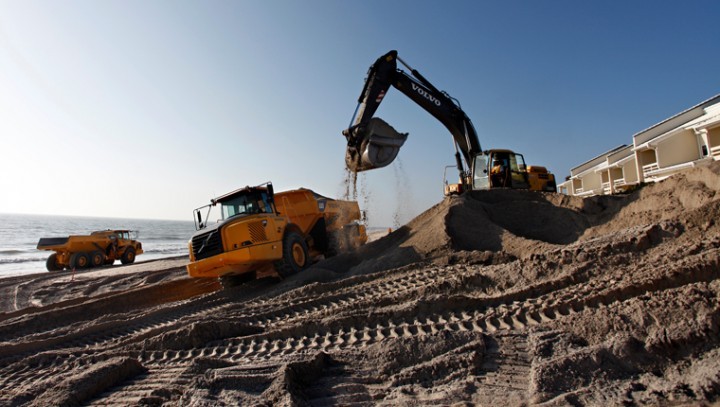
INDIAN RIVER COUNTY — Despite on ongoing court dispute over $60,000 that caused county commissioners to swear off trucked-in sand projects, sand miners Steve Smith and Chuck Cramer presented an optimistic, united front Monday during a postmortem on the 6.6-mile north county sand replenishment project.
They blamed Mother Nature, state environmental regulators and mechanical breakdowns for massive time delays and cost overruns as the Lessons Learned Subcommittee of the Indian River County Beaches and Shores Committee rehashed the details of the three-year project in the county commissioners’ conference room.
The committee and the contractors agreed that weather caused major delays in processing the trucked-in sand operation. Barring a major storm event, weather does not interfere with the traditional method of pumping sand via large pipes and a dredge rig from an off-shore area of the ocean floor about a mile from Round Island Park beaches.
Subcommittee Chairman Bob Anderson asked the miners and dredgers how many days crews would typically lose from one rain day.
“One day of hard rain could cause three or four days of delays,” Cramer said.
It wasn’t mentioned during Monday’s meeting, but dirt roads leading to the mine also got rutted and washed out, denying dump trucks access to the sand until the ground dried out. So even on days when it rained and sand was stockpiled, trucks sometimes could not get the sand to the beach.
Weather wreaked havoc with the first phase of the project, which unfortunately coincided with what Smith called, “The wettest March in history” in March 2010.
“We worked 24 hours a day to catch up,” Smith said. “Just that month alone we lost 20 days. That was the anomaly of the project. On average we lost eight days a month.”
The project was also delayed about a month because the Florida Department of Environmental regulation changed the specifications on the size and quality of sand that DEP wanted on the beach.
The size and characteristics of the sand from the off-shore source – which the county had always bought – was used to design the project. When upland sand mine material was factored into the equation, the project had to be redesigned and miners were given different standards.
“It was a learning curve for everybody,” Cramer said.
The first phase of the project came under close scrutiny to see if sea turtles would nest in the mine-produced sand. By all accounts, the new sand was a great success with regard to sea turtle nesting.
County officials have also praised the sand as the best-quality sand the county has ever put on the beach.
But the delays and missteps of the beginning of the project were costly, both to the taxpayers and to the contractors mining the sand.
“We took a tremendous beating on Phase One,” Cramer said, explaining that the mines and dredge crews could no longer afford to produce sand in advance in the second phase of the project. That led to a request for the county to prepay for the next crop of sand. Fuel prices also soared in late 2010 and early 2011, causing the county to reluctantly approve more money to keep truckers and miners from walking off the job.
Cramer, who manages dredging operations for Henry Fischer and Sons, Ranch Road Lake sand mine owner Smith, as well as most of the members of the committee, seemed to avoid the fact county commissioners last month said they would not repeat the trucked-in sand effort – at least not with the same contractors.
Smith said that he and Cramer are friends, despite everything that’s happened. Regarding the status of the lawsuit, he said they are hopefully working toward resolving the dispute sometime soon. Sanguine about the future, Cramer and Smith pitched the bright side of trucked-in sand, clearly serving their joint economic interests.
“It’s absolutely do-able,” Cramer said. “I would do it again in a minute.”
Acknowledging that no one can control the weather, some practical suggestions tossed out by managers on the project was to have extra processing machines, called “screens,” on site to catch up after a rain delay. But that doesn’t come cheap.
“You would need to bring in four screens at $10k per month and you’re doubling your cost,” said Steve Smith.
With regard to the cost, Cramer reminded the group that a trucked-in sand project involves not only the service of shoring up the beach, but also the product of the sand itself.
“There’s something everybody’s got to keep in mind. As upland source producers, we’re creating the product and then transporting it,” Cramer said. “The offshore process, they’re not creating anything, they’re transporting your sand.”
Because dredging crews that pump sand from off-shore do not have to make the sand from scratch, they can generally work a lot faster. Using off-shore sand, the county could have started the project in November 2009 and been completed sometime in January 2010.
At the end of 2010, the county was beginning Phase Two of the project, which would turn into Phase 2B during a third season.
“I think there’s a few things that we know about equipment-wise that we would do a little different,” Cramer said.
Phase Two of the project ground to a screeching halt when a critical part of a dredge stopped working.
Relations between Ranch Road Lake and Fischer and Sons broke down as well, after the equipment broke. Eventually, a dredge crew from Louisiana had to be brought in to produce the sand. The last 1,500 feet of dune had to be left unfinished due to lack of appropriate sand to put on the beach.
The project ended up 25,000 cubic yards of sand short.
Anderson said the Lessons Learned Subcommittee will meet again to finish analyzing all the factors that came to play in the north county beach project.



